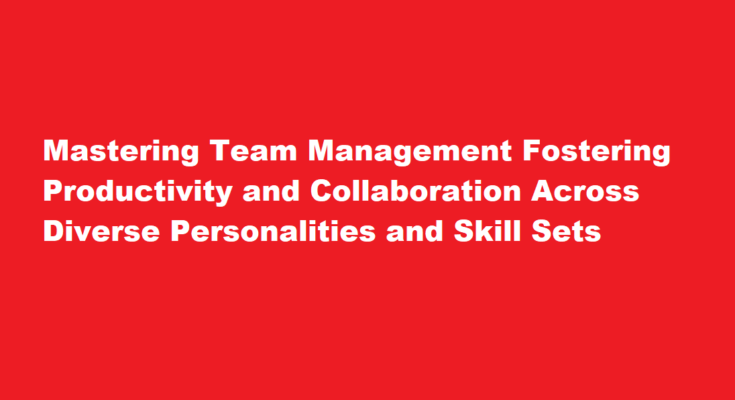Effective team management is a cornerstone of successful businesses, and in today’s globalized and multifaceted work environment, diverse teams with a wide range of personalities and skill sets are becoming increasingly common. While such diversity can bring fresh perspectives and innovative solutions, it also poses challenges that require adept management to ensure high productivity and seamless collaboration. In this article, we will delve into strategies for effectively managing a team of diverse personalities and skill sets to foster productivity and collaboration.
Embrace Diversity Recognize and Celebrate Differences
The first step to managing a diverse team is acknowledging and appreciating the differences in personalities and skill sets. Each team member brings a unique background and perspective, which can be a powerful asset if harnessed correctly. Create an inclusive environment where every voice is valued and differences are celebrated. Encourage open discussions and idea-sharing sessions that promote cross-pollination of ideas.
Clear Communication The Foundation of Collaboration
Effective communication is the cornerstone of successful team management. Tailor your communication style to accommodate the diverse personalities on your team. Some team members might prefer direct and concise communication, while others might appreciate more context and detail. Regular team meetings and one-on-one sessions can help bridge communication gaps and ensure that everyone is on the same page.
Set Clear Goals and Expectations
Clarity in goals and expectations is essential to keep the team aligned and focused. Clearly define project objectives, individual roles, and responsibilities. When each team member understands their contributions and the overall team direction, they are more likely to work cohesively and stay motivated.
Utilize Strengths Leverage Individual Skills for Collective Success
Diverse skill sets are a treasure trove waiting to be unlocked. Identify each team member’s strengths and allocate tasks accordingly. By leveraging individual skills, you can create a well-rounded team that complements each other’s abilities. This not only enhances productivity but also fosters a sense of value and contribution among team members.
Encourage Flexibility Adaptability in Team Dynamics
A diverse team often requires flexibility in terms of work styles and schedules. Some team members might thrive in structured environments, while others prefer a more fluid approach. Find a balance that accommodates different work preferences and allows team members to perform at their best.
Conflict Resolution Turning Differences into Opportunities
Diverse personalities can occasionally lead to conflicts, but these can also be opportunities for growth. Encourage open discussions and provide a safe space for conflicts to be addressed. Train your team in conflict resolution techniques and emphasize the importance of empathy and active listening.
Promote Collaboration Fostering a Culture of Teamwork
Collaboration is the bedrock of a high-performing team. Create opportunities for team members to collaborate on projects, share ideas, and provide feedback. Cross-functional projects and brainstorming sessions can stimulate creativity and promote a culture of teamwork.
Professional Development Nurturing Continuous Growth
Investing in the professional development of your team members benefits both individuals and the team as a whole. Offer opportunities for skill enhancement, whether through workshops, training, or mentorship programs. When team members see that their growth is valued, they are more likely to stay motivated and engaged.
Lead by Example Demonstrate Respect and Inclusion
As a team leader, your behavior sets the tone for the entire team. Model the behavior you want to see – show respect for diverse perspectives, actively seek input from all team members, and demonstrate a commitment to inclusivity. When your team witnesses these values in action, they are more likely to follow suit.
Feedback and Recognition Reinforce Positive Behavior
Regular feedback and recognition are crucial for maintaining high productivity and motivation. Acknowledge individual achievements and efforts publicly, and provide constructive feedback privately. A culture of feedback helps team members understand their strengths and areas for improvement, fostering continuous growth.
FREQUENTLY ASKED QUESTIONS
How can you work to increase collaboration among members of a diverse team?
Continuously seek input from team members, recognizing and respecting their different perspectives and motivations. Leverage the strengths and innovative ideas of the diverse team members. Acknowledge contributions of others in an appropriate way. Explicitly acknowledge and manage the dynamics of a diverse team.
What are the 4 aspects of a diverse workplace?
Diversity in the workplace means having a workforce inclusive of different backgrounds and national origins. It means gender, socioeconomic, and cultural diversity — and beyond. It also means that the organization fosters a sense of belonging that makes everyone feel like they are part of the team.
In conclusion, managing a team with diverse personalities and skill sets requires a thoughtful approach that values differences, encourages collaboration, and promotes effective communication. By embracing diversity, setting clear goals, leveraging strengths, and fostering an inclusive environment, you can create a team that thrives on its unique composition. Remember that effective team management is an ongoing process that requires adaptation, open-mindedness, and a commitment to nurturing both individual growth and collective success. With these strategies in place, you’ll be well on your way to achieving high productivity and seamless collaboration within your diverse team.



